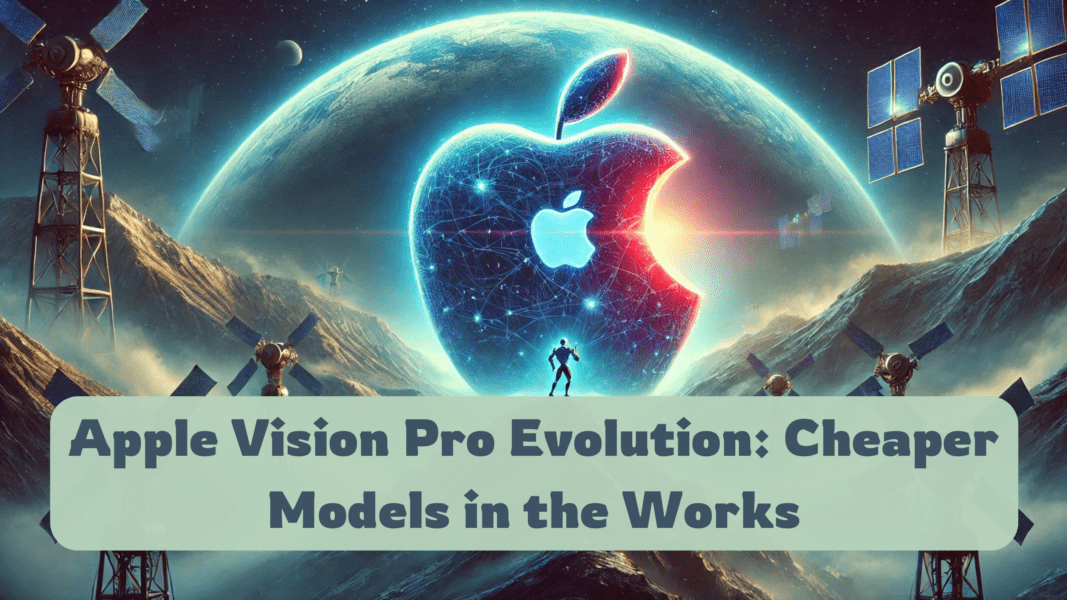The Apple Vision Pro revolutionary foray into the VR/AR/XR space, is an undeniable marvel of modern technology. However, its staggering $3,500 price tag places it out of reach for most consumers. Apple, keenly aware of this limitation, is strategizing ways to make its next-generation Vision Pro—and an entirely new, more affordable headset—accessible to a broader audience.

According to a report by Taiwanese research firm TrendForce, Apple is preparing to launch two distinct products: an updated Vision Pro and a cheaper, more mainstream version tentatively called the “Apple Vision.” By simplifying features and optimizing production, Apple aims to strike a balance between premium quality and affordability.
What Changes Are Coming to the Apple Vision Pro?
To cut costs for the next-generation Vision Pro, Apple plans to source components from a wider range of suppliers. Currently, the company relies heavily on Sony for high-end displays used in the Vision Pro. Diversifying its supplier base could foster competition, driving down production expenses.
Apple CEO Tim Cook has openly acknowledged that the Vision Pro’s high price tag limits its market appeal.
“At $3,500, it’s not a mass-market product,” Cook stated in a recent interview. “Right now, it’s an early-adopter product. People who want tomorrow’s technology today—that’s who it’s for. Fortunately, there are enough people in that camp to make it exciting.”
Also Read: Apple Releases iOS 18.3 and macOS Sequoia Betas
Introducing the Affordable “Apple Vision”
The rumored “Apple Vision” headset could mark a significant shift in Apple’s approach to immersive technology. By removing the “Pro” designation, Apple signals a focus on mainstream users. While precise details remain speculative, TrendForce suggests that Apple might use OLED displays and LCDs with LTPO (low-temperature polycrystalline oxide) backplane technology for this model.
LTPO displays offer a practical blend of performance and cost-efficiency. They maintain high refresh rates and vibrant visuals while consuming less power—essential for extended VR/AR use. This strategic choice could enable Apple to deliver a premium experience at a significantly reduced price point.
Key Features Likely to Be Retained or Modified
To lower the price, Apple might make the following adjustments to the “Apple Vision” model:
- Display Technology: Switching from micro-OLED displays to a mix of OLED and LTPO LCD screens.
- Material Choices: Using lighter, less expensive materials for the headset body without sacrificing durability.
- Chipset: Opting for slightly less powerful processors while maintaining seamless performance for everyday applications.
- Audio System: Simplifying spatial audio capabilities.
- Accessories: Reducing the included accessories or offering them as optional add-ons.
Also Read: Apple vs. Meta Clash Over Interoperability and Privacy Concerns
The Potential Impact on the Industry
Should Apple succeed in creating a more affordable VR/AR headset, the market dynamics could shift dramatically. A reasonably priced Apple Vision would bring competition to companies like Meta, which has established itself as a leader with its Quest 3 headset.
Meta’s Quest 3, priced at a fraction of the Vision Pro, caters to casual VR enthusiasts and offers solid features. If Apple’s streamlined “Vision” can undercut the Quest 3 without compromising on Apple’s hallmark quality, Meta and other competitors may be forced to rethink their pricing and innovation strategies.
What Does This Mean for Consumers?
A more affordable Apple Vision would open the door for a wider range of users to explore immersive technologies. The applications extend beyond gaming, encompassing education, healthcare, workplace collaboration, and creative industries.
Lowering the barrier to entry would also accelerate the adoption of AR/VR in everyday life, solidifying Apple’s role as a leader in this evolving space.
Also Read: Apple Magic Mouse Overhaul Tackles Longstanding Charging Port Issue
Future Plans for the Vision Pro and Apple Vision
According to TrendForce, Apple is not merely stopping at price reduction. The company is reportedly working on integrating groundbreaking features like enhanced hand-tracking, expanded app ecosystems, and improved battery life.
Tim Cook hinted at these developments, stating, “We’re building not just for today but for the future. Every iteration brings us closer to the ultimate goal of making AR/VR accessible and indispensable.”
FAQs
- What is the Apple Vision Pro?
The Vision Pro is Apple’s high-end VR/AR/XR headset featuring advanced displays, spatial audio, and a $3,500 price tag. - What is the “Apple Vision”?
The Apple Vision is a rumored affordable version of the Vision Pro, designed for mainstream users. - How does Apple plan to reduce costs for the Vision Pro?
By sourcing components from multiple suppliers and simplifying certain features. - What display technology might the Apple Vision use?
It could feature OLED and LTPO LCD displays for a balance between performance and affordability. - How does the Vision Pro compare to Meta’s Quest 3?
The Vision Pro is a premium product, while the Quest 3 offers a more budget-friendly VR experience. - When will the Apple Vision be released?
No official date has been announced, but reports suggest development is underway. - Will the Apple Vision include spatial audio?
It’s likely the spatial audio features will be simplified to reduce costs. - What is LTPO technology?
LTPO (low-temperature polycrystalline oxide) is a display technology offering high refresh rates and lower power consumption. - Will the Apple Vision support gaming?
Yes, gaming will likely remain a key focus, along with other applications like education and collaboration. - What price range can we expect for the Apple Vision?
While the exact price is unknown, it will likely be significantly cheaper than the Vision Pro’s $3,500 price.

